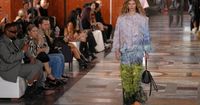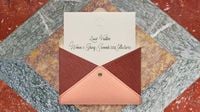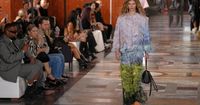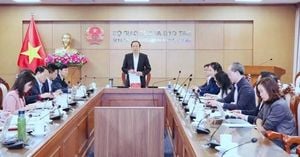On September 30, 2025, the world’s fashion spotlight turned to Paris, where Louis Vuitton’s Spring/Summer 2026 womenswear collection took center stage inside the southern wing of the Louvre Museum. But this was no ordinary runway show. With the city’s famed pyramid looming outside and the historic summer apartments of Anne of Austria transformed into a dreamlike salon, designer Nicolas Ghesquière delivered a spectacle that blended the intimacy of home with the grandeur of French history.
According to Reuters, models glided through the gilded salons in flat, slipper-like shoes, draped in soft knits, silky pyjama-style trousers, and loose bermudas. The atmosphere was calm and inviting, a sharp contrast to the frenzied scene outside, where crowds of screaming fans clogged the Louvre’s entrances and snarled Parisian traffic. They weren’t there for the Mona Lisa this time—they came for Louis Vuitton, and perhaps just as much for the star-studded front row.
The guest list was a who’s who of global pop culture. As reported by the Associated Press, Emma Stone and Zendaya sat side by side, joined by Jennifer Connelly, Jaden Smith, Ana de Armas, and Sophie Turner. K-pop icons Lisa and Felix were also present, with Lisa even posing for photos alongside France’s First Lady, Brigitte Macron. The front row itself became a second stage, amplifying the brand’s message in real time and underscoring how, in today’s fashion world, celebrity presence is as critical as the clothes themselves.
The show’s setting was as meticulously curated as the garments. Art Deco chairs mingled with 19th-century sculptures, and sunlight poured through 17th-century windows, once graced by royalty. Ghesquière, who has helmed Louis Vuitton’s womenswear since 2013, leaned into the concept of private elegance made public. The set was styled as a contemporary apartment, an audacious move that turned the idea of home into a public spectacle. It was, as Ghesquière described, “a celebration of intimacy and the boundless freedom of the private sphere,” and “an exploration of archetypes of genre” that elevates the “ultimate luxury of dressing for oneself.”
Fashion critics noted the collection’s masterful fusion of past and present. The Associated Press detailed how Ghesquière’s designs played with Renaissance echoes—corseted waists, Juliette sleeves, tubular arms—alongside giant silk turbans and feathered collars that mimicked fur. Baggy, sultan-style trousers brought an Eastern flair, while a striped, ruffled coat nodded to the Pierrot clown, and bejeweled gowns gleamed against the backdrop of Louvre murals. The result was a series of vivid chapters: time-travel hybrids that clipped historical references to modern attitudes, with tailoring that floated and corsetry that moved. “Travel as code: an apartment inside a museum for a house built on motion,” wrote AP’s Thomas Adamson, capturing the collection’s restless spirit.
Ghesquière’s vision was further underscored by a reflective reading of David Byrne lyrics, performed by Cate Blanchett, which kept the mood contemplative amid the visual feast. The designer’s commitment to continuity stood out during a week when Paris Fashion Week was abuzz with change. Major houses like Chanel, Balenciaga, Loewe, Dior, and Jean Paul Gaultier were introducing new creative directors, a creative reset designed to reignite demand as the luxury sector faces softer spending in China and fresh U.S. tariff headwinds. In the midst of this musical-chairs moment, Ghesquière’s steady hand offered a reassuring anchor for Louis Vuitton.
Of course, no fashion week is without its critiques. Some observers noted, as AP did, that while Ghesquière’s storytelling dazzled in individual scenes—the Pierrot styles, Ottoman trousers, and silk turbans each striking in their own right—the collection sometimes felt more like a series of captivating vignettes than a single, cohesive narrative. And while the theme of intimacy was celebrated, the garments themselves were anything but everyday; concept and embellishment often outpaced repeatable wardrobe options. Yet, for many, this was precisely the point: Louis Vuitton’s runway was less about practicality and more about making fashion a “manifesto of individuality.”
Reuters and AP both highlighted that Ghesquière’s position at Louis Vuitton is something of a rarity in today’s fashion landscape. Having designed for the brand since 2013, he is one of the few creative directors to have weathered the industry’s recent waves of change. As Paris Fashion Week continues through October 7, 2025, with debuts from Chanel, Balenciaga, and Loewe on the horizon, Ghesquière’s longevity and vision stand out as a testament to both his talent and the brand’s faith in his direction.
The broader context of the event was impossible to ignore. As Wonderland Magazine chronicled, Paris Fashion Week 2025 has been a whirlwind of creative director debuts, surprise moments (including a Chanel runway-crashing pigeon), and headline-grabbing collaborations. Louis Vuitton’s show, with its modern twist and house ambassadors like Saoirse Ronan and Lisa starring in recent campaigns, was a reminder of the French Maison’s ability to both honor tradition and push boundaries. The fashion world may be in a state of flux, but some houses—like Vuitton—manage to hold their own amid the chaos.
Beyond the spectacle of the runway and the glamour of the guest list, there was a palpable sense of history in the air. The Louvre, home to centuries of art and culture, became the backdrop for a collection that asked what it means to dress for oneself in an age of spectacle. Ghesquière’s answer was both poetic and pointed: serenity, individuality, and a touch of theatricality are the new luxuries.
As Paris Fashion Week carries on, the city remains abuzz with anticipation for what’s next. But for one afternoon at the Louvre, all eyes were on Louis Vuitton—a moving masterpiece in its own right, making the case that fashion can still surprise, enchant, and, above all, express the deepest parts of ourselves.






